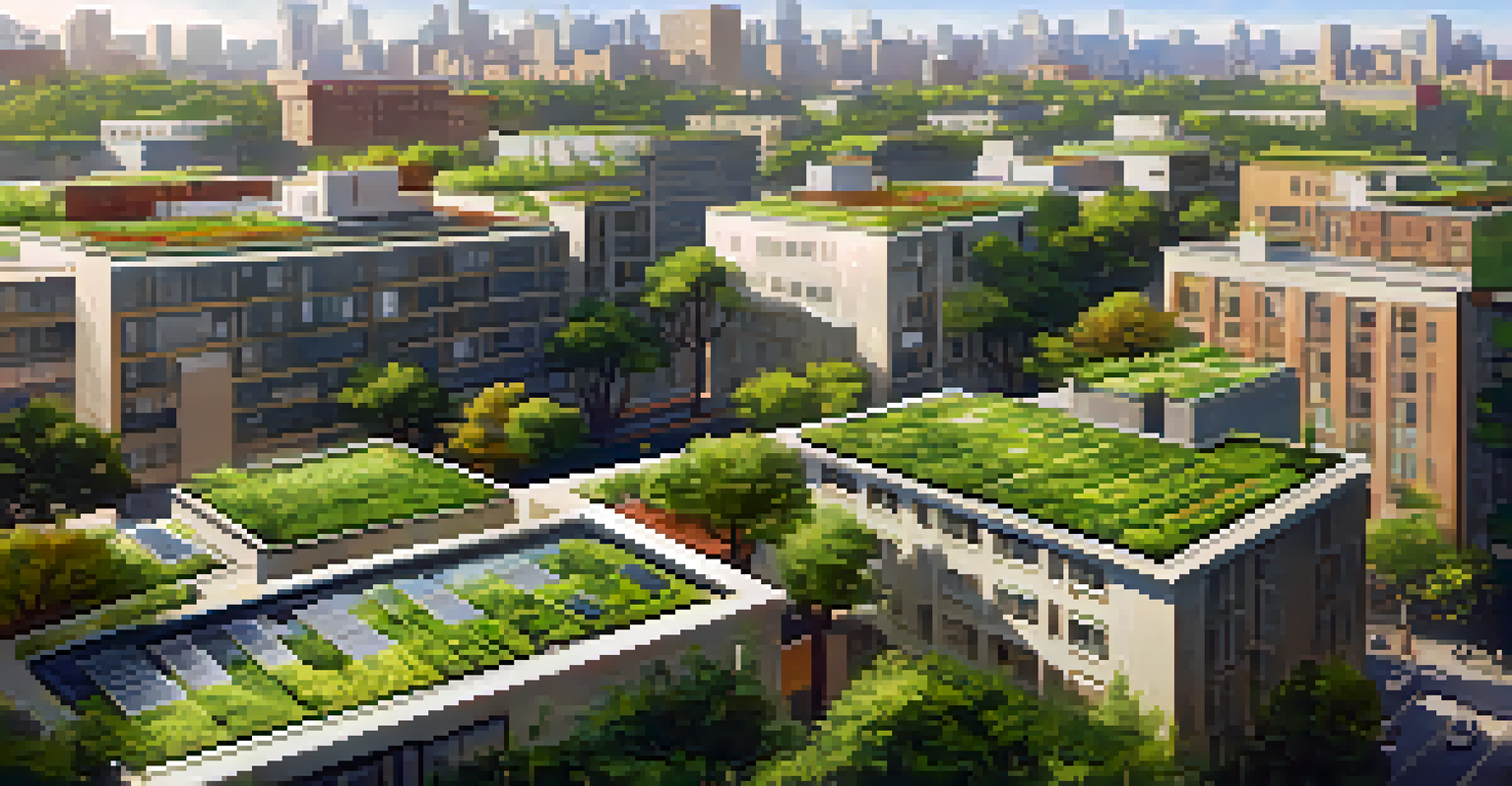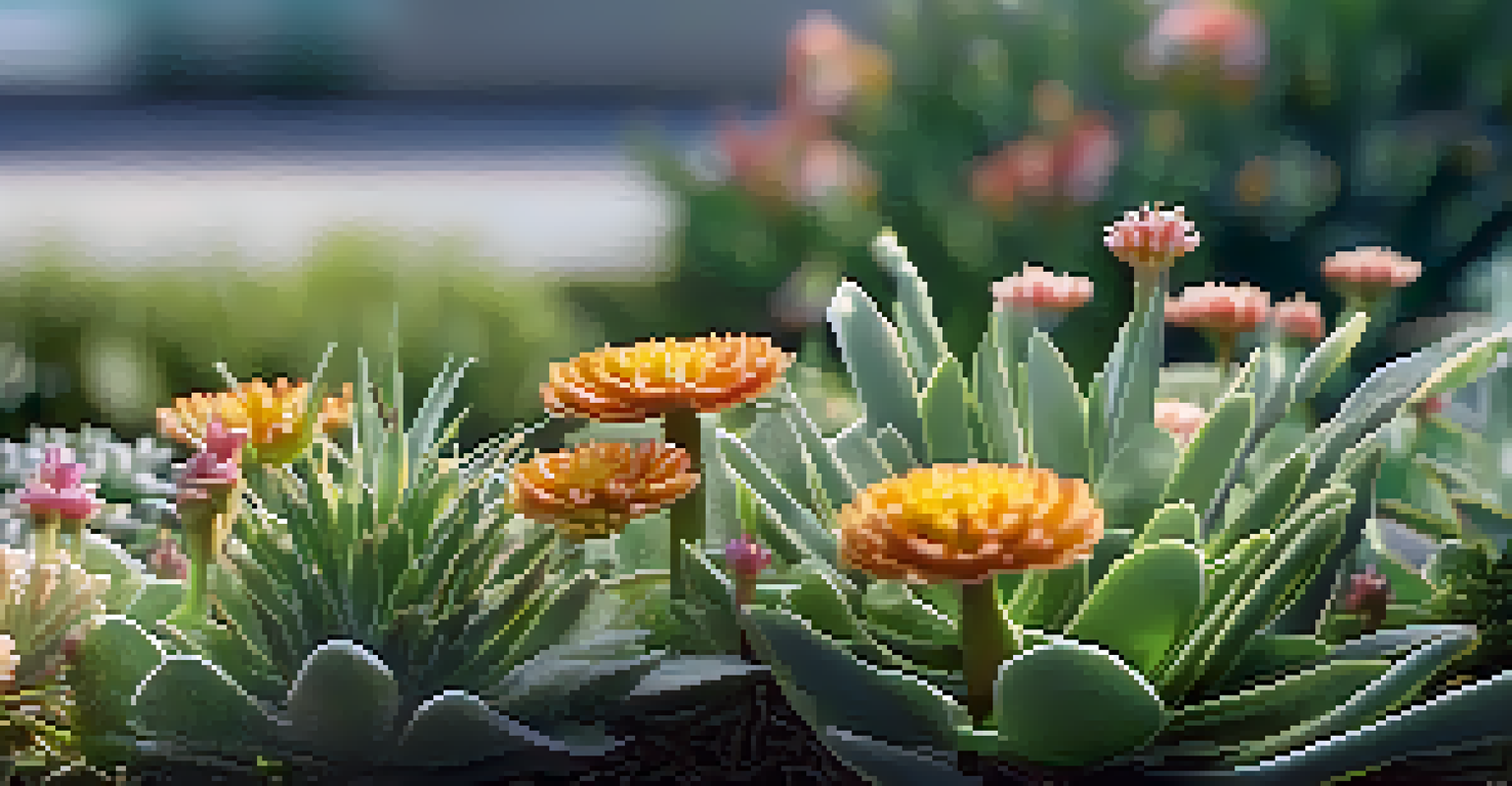Mitigating Climate Change Effects with Green Roofs

Understanding Green Roofs and Their Benefits
Green roofs are not just a trendy architectural feature; they play a crucial role in urban ecology. Essentially, they involve growing vegetation on rooftops, which helps insulate buildings and reduce energy costs. This simple yet effective approach can also improve air quality and enhance biodiversity in urban areas.
The clearest way into the Universe is through a forest wilderness.
Beyond aesthetics, green roofs capture rainwater, reducing runoff and lowering the risk of flooding. They act like sponges, absorbing water and releasing it slowly, which is vital in cities where concrete dominates. This can mitigate the urban heat island effect, making cities cooler and more livable.
Moreover, the plants on green roofs can sequester carbon dioxide, a key greenhouse gas contributing to climate change. By converting CO2 into oxygen, they help purify the air and contribute to a healthier environment, benefiting both humans and wildlife.
The Role of Green Roofs in Urban Cooling
Urban areas tend to be significantly warmer than their rural counterparts, a phenomenon known as the urban heat island effect. Green roofs can help combat this by providing a layer of insulation that keeps buildings cooler in the summer. This reduction in temperature can lead to decreased reliance on air conditioning, which in turn lowers energy consumption.

For instance, studies have shown that buildings with green roofs can experience energy savings of up to 75% during peak summer months. This is not only beneficial for individual building owners but also contributes to a collective reduction in energy demand in cities.
Green Roofs Enhance Urban Ecology
Green roofs improve air quality, reduce energy costs, and support biodiversity in urban areas.
Additionally, the cooling effect of green roofs can extend beyond the building itself, positively influencing surrounding areas. As more roofs are transformed into green spaces, the overall temperature of the urban landscape can decrease, enhancing comfort for residents and reducing heat-related health issues.
Improving Air Quality with Green Roofs
Air pollution is a significant problem in many urban centers, affecting both health and quality of life. Green roofs can help mitigate this issue by filtering pollutants and trapping dust and particulate matter. The plants act as natural air purifiers, absorbing harmful gases and releasing oxygen.
People who will not sustain trees will soon live in a world that will not sustain people.
For example, studies have indicated that green roofs can remove up to 60% of airborne particulates, which is crucial for improving urban air quality. This becomes especially important in densely populated areas where vehicle emissions and industrial activities contribute to pollution.
Moreover, increasing green spaces in cities can lead to a more pleasant atmosphere, encouraging outdoor activities and social interactions. Improved air quality can result in lower rates of respiratory diseases, thus benefiting public health overall.
Enhancing Biodiversity in Urban Areas
Urban environments often lack natural habitats, making it challenging for wildlife to thrive. Green roofs can serve as vital green spaces that promote biodiversity, offering habitats for birds, insects, and other organisms. This is essential for maintaining ecological balance within city landscapes.
By incorporating native plants into green roof designs, we can attract local wildlife and create corridors that link fragmented habitats. For instance, many cities have reported increased sightings of pollinators like bees and butterflies on green roofs, showcasing their potential as biodiversity havens.
Economic Gains from Green Roofs
Investing in green roofs can lead to long-term savings on energy bills and increased property values.
Furthermore, a diverse ecosystem on green roofs can also enhance the resilience of urban flora and fauna. These interconnected green spaces can help species adapt to changing climates, supporting a healthier urban ecology and enriching the local environment.
Economic Benefits of Green Roofs
Investing in green roofs can lead to significant economic advantages for both property owners and municipalities. The initial costs of installation may be offset by long-term savings on energy bills, as green roofs provide excellent insulation and reduce heating and cooling needs. Over time, these savings can add up substantially.
Additionally, green roofs can increase property values. Buildings with green roofs are often seen as more desirable due to their environmental benefits and aesthetic appeal, attracting tenants or buyers willing to pay a premium. This can be especially beneficial in competitive real estate markets.
Moreover, cities that promote green roofs can benefit from reduced infrastructure costs. By managing stormwater runoff more effectively, municipalities can decrease the burden on drainage systems, leading to lower maintenance costs and enhanced public safety during heavy rain events.
Challenges and Solutions for Green Roof Implementation
While the benefits of green roofs are clear, there are challenges to their widespread implementation. Factors such as high installation costs, structural requirements, and maintenance concerns can deter property owners from investing in this eco-friendly solution. However, with proper planning and incentives, these barriers can be overcome.
Cities can play a pivotal role by offering grants, tax incentives, or technical assistance to encourage green roof adoption. Educational programs can also help property owners understand the long-term benefits, making them more willing to invest in green technology.
Overcoming Green Roof Challenges
Addressing installation costs and maintenance can be achieved through city incentives and collaboration among professionals.
Collaboration among architects, engineers, and landscape designers is essential to ensure that green roofs are designed for longevity and low maintenance. By utilizing appropriate plant selections and irrigation systems, we can create sustainable green roofs that thrive and provide maximum benefits to urban environments.
Future Trends in Green Roof Technology
The future of green roofs looks promising, with ongoing advancements in technology and design. Innovations such as modular green roof systems and smart irrigation techniques are making it easier and more cost-effective to install and maintain green roofs. These developments can significantly enhance their adoption across urban landscapes.
Additionally, the integration of renewable energy sources, such as solar panels on green roofs, is becoming more common. This not only maximizes space but also contributes to energy efficiency, creating a dual-purpose solution that addresses climate change from multiple angles.

As cities continue to grow, the push for sustainable urban development will likely drive the expansion of green roofs. With increasing awareness of climate change and its impacts, communities will seek innovative solutions like green roofs to create healthier, more resilient urban environments.